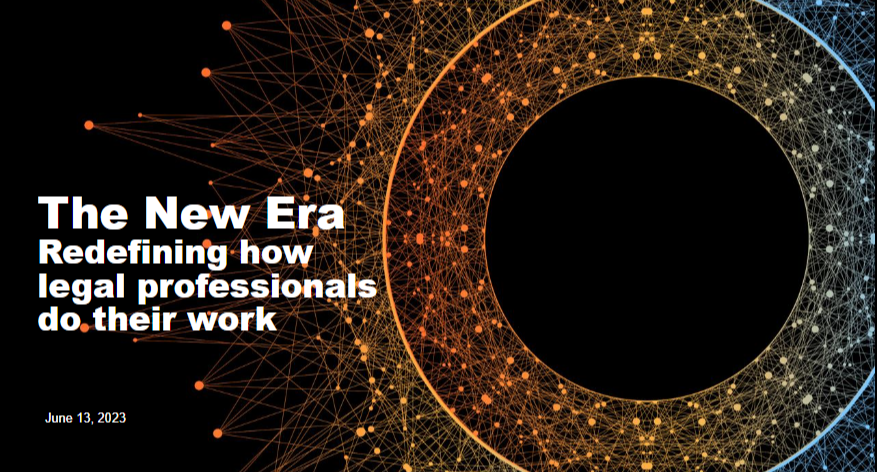Generative AI in Action: Product Demos for Thomson Reuters Suite of Legal Solutions

Leaders from the Thomson Reuters Legal Professionals business hosted a webinar with product demos to show how generative AI will be integrated across the legal product suite. The sneak peeks included Westlaw Precision, Practical Law, and Legal Drafting tools.
Legal Current is sharing highlights of the session, where Paul Fischer, president of Legal Professionals; Mike Dahn, head of Westlaw Product Management; Emily Colbert, head of Product Management, Know How and Compliance; Joel Hron, vice president of Technology; and Rawia Ashraf, vice president of Product Management discussed how Thomson Reuters will shape the future of work in the legal profession.
Fischer opened the webinar by noting how the company’s 150-year history of customer-driven innovation and trusted legal content “provide a solid foundation for our ongoing product-development efforts.”
“We have embraced machine learning and natural language processing technology for more than 30 years to build the industry’s most comprehensive collection of richly enhanced data, supported by the West Key Number System taxonomy that we developed to organize the law,” Fischer said. “Our rich history of customer partnership and innovation has positioned us to capitalize on generative AI and large language models, or LLMs.”
Fischer noted that AI already drives the search algorithms that bring Thomson Reuters content to the surface.
Retrieval Augmented Generation
Hron explained how Thomson Reuters is applying generative AI and LLMs to provide customers with intuitive automation, time savings, and a significantly improved user experience. He noted generative AI will have a “profound impact” on the legal industry given the significant amount of document-based content used in the profession.
“We don’t view generative AI as a replacement or a displacement necessarily of humans or jobs,” Hron said. “We view humans as a critical component in the loop of generative AI.”
Hron said some legal tasks will be augmented or fully automated by generative AI, but that humans will be essential to understanding, controlling, and mitigating the risks of generative AI outputs.
He explained that Thomson Reuters uses a technique called Retrieval Augmented Generation (RAG) to help reduce errors by grounding LLMs with reliable content. Hron said Thomson Reuters employs this technique in a variety of pre-processing and post-processing activities to provide accurate responses.
“We see generative AI as a new capability to further connect our product capabilities and bring together the capabilities of legal research with legal workflow together in a way that we haven’t been able to do previously,” Hron said. “The dialogue-centric nature that generative AI brings to software is something unique that we have not experienced in software before, and we are looking to leverage it across our suite of products in the legal space.”
Westlaw Precision
Dahn demonstrated generative AI capabilities in Westlaw Precision, including a new feature called Ask Westlaw. He said Ask Westlaw can answer general legal research questions as well as questions about specific documents and content sets.
“Ask Westlaw combines the power of LLMs with our proprietary editorial enhancements and our authoritative content on Westlaw to bring you much faster answers to your legal research questions,” Dahn said. “With Ask Westlaw, we’re using LLMs and our proprietary content to bring back a synthesized answer from a wide variety of content that answers your question very clearly and provides authority so that you can verify the result and dig further to understand the nuance of the law.”
Dahn acknowledged customers’ concerns over accuracy and said Thomson Reuters is prioritizing getting it right.
“In addition to RAG technology, we’re also engaging in a lot of pre-processing and post-processing to verify the accuracy of results,” Dahn said.
He added that Ask Westlaw will save users time and deliver answers much faster.
“The combination of Ask Westlaw and LLM technology, combined with our authoritative content and traditional tools like KeyCite and the Key Number System, will provide you significant advantages in your research.”
Practical Law and Drafting Tools
In addition, Colbert shared how generative AI will enable Practical Law users to get their answers faster.
“People already come to Practical Law to get quick answers to complex questions, to get up to speed on what’s new, and to find model language to get started drafting,” she said. “With LLMs, we’re able to bring that to customers even faster with trusted answers from Practical Law.”
“What’s exciting about generative AI is the opportunity to connect the expertise from Practical Law, but bring it out of the research experience and bring it into Word, where the user is working, and then take that journey even further,” Colbert said.
In the final product demo, Ashraf showed how Drafting tools will use generative AI to help users draft and modify clauses from within Microsoft Word.
“We’re bringing together a lot of the Practical Law capabilities and other Thomson Reuters capabilities into our Drafting solution,” she said.
She noted that the Drafting tool brings together Westlaw, Practical Law, Thomson Reuters Document Intelligence, generative AI capabilities, and Microsoft Word.
“We’re bringing all these powerful capabilities into an environment where we know attorneys and legal professionals are working.”
Proprietary Content and Human Expertise
“Our approach to generative AI starts with you, our customers,” Fischer concluded. “We aim to solve your biggest pain points and design solutions to help you focus your time where it matters most by leveraging our strongest assets: our proprietary content and our human expertise for training and tuning AI models. We know that this new technology will be much better when informed by your insights.”
To that end, Fischer encouraged webinar attendees to sign up on TR.com/AI for insights and updates on how Thomson Reuters is integrating generative AI across its legal solutions.
To listen to the webinar, register here to access the recording.